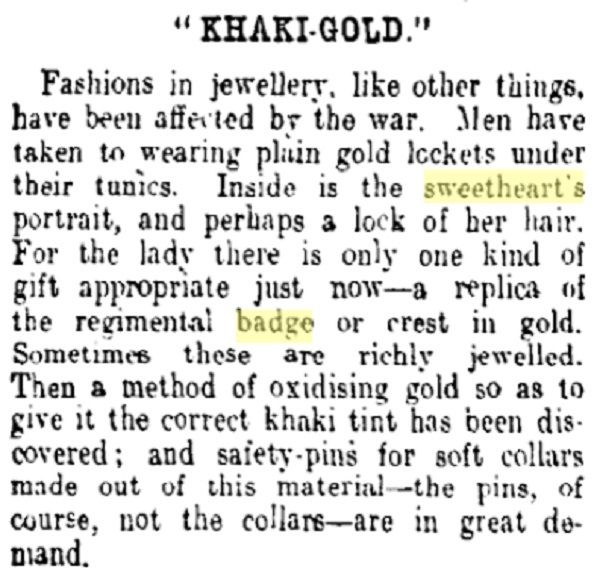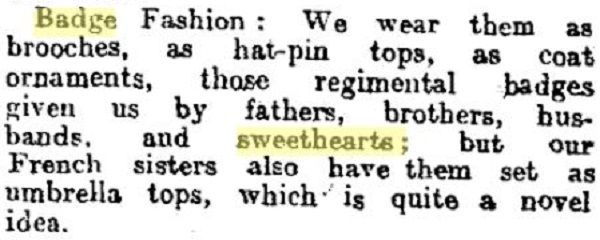
 |
Recent Books by Forum Members |

 |
 |
|
|
|||||||
 |
|
|
Thread Tools | Display Modes |
|
#1
|
||||
|
||||
|
Hi all.
Looking for opinions on this one. The clasp looks factory to me, but not 100% sure. Thanks Colin
__________________
"The Devonshires held this trench. The Devonshires hold it still " "One day I'll leave you, a phantom to lead you in the Summer, to join the Black Parade" |
|
#2
|
||||
|
||||
|
It looks like a sweetheart conversion to me, the catch and pin are on oval pads that are soldered on to the badge then perhaps gilded after.
|
|
#3
|
|||
|
|||
|
Hi Colin
The badge looks good to me. I have a Gaunt produced NZ 11th Taranaki badge with a pin clasp on oval pads in the same manner as your badge. I am more than happy with it - a good quality 'sweetheart' badge. Talking about 'sweetheart badges' why is it that it is assumed that a badge with a clasp was specifically made for someone's sweetheart. I have several silver NZ reinforcement badges with clasps that I have obtained from the UK. These reinforcement badges were manufactured by jewellers in the training camps in NZ prior to departure for overseas. When the soldiers arrived in the UK these badges were replaced with badges of the units they were posted to. If I had bought an expensive silver badge I would have most likely bought one with a much more secure clasp than lugs, which can be more easily broken and the badge possibly lost. In turn, these could have been later given to and worn by a sweetheart. I have a a NZ Engineer's medals, together with his badges, title and uniform buttons etc that he wore at Gallipoli and subsequently France. He replaced the lugs on his cap badge with a clasp, which would be much stronger than lugs. I can only assume he did this as he did not wish to lose his cap badge that he had worn since he enlisted and which he had become attached to. Just my musings. Cheers John |
|
#4
|
||||
|
||||
|
Thanks John
Very interesting musings, too. I know very little about "sweetheart" badges, and have just assumed they were just that. Your input and thoughts lead me to understand there are often more to them as they could well made for use by the soldier himself (as you say, more secure, perhaps, than lugs). As Magpie mentions, it looks be regilded after clasp replacement, and the clasp, pin and soldering seems to be good quality. I'm pleased with that! Cheers Colin
__________________
"The Devonshires held this trench. The Devonshires hold it still " "One day I'll leave you, a phantom to lead you in the Summer, to join the Black Parade" |
|
#5
|
||||
|
||||
|
Sweetheart is just a term I would use for a badge that's been altered for pinning it to something other than just a cap like a suit or a ladies dress, it's not something that I agree with with calling them sweethearts but seems to be the accepted term to use, these solder on pads used to be sold on cardboard sheets in various sizes and finnishes just as you may buy a comb from your barbers and could be put on relatively easily just as you may use an epoxy resin to glue a modern pin assembly from your local craft shop, I'd also disagree with the lugs and split pin being far less secure than a light duty pin as the one shewn above if used properly.
If the badge was made with lugs as the means of fastening to the hat and have been replaced and perhaps gilded as this one looks like from the pictures then Colin may or may not be happy with it, personally I think it's a nice badge worthy of a place in a collection with its history wether it's been worn on a cap or worn by a girlfriend,wife,father or the man's own suit after the war. |
|
#6
|
||||
|
||||
|
A few of mine, mostly with the pad type pins
|
|
#7
|
||||
|
||||
|
That's a great collection! You could say that being worn as a pinned badge post-service adds to the history of the badge!
Cheers Colin
__________________
"The Devonshires held this trench. The Devonshires hold it still " "One day I'll leave you, a phantom to lead you in the Summer, to join the Black Parade" |
|
#8
|
||||
|
||||
|
I have as yet not come across any wartime advertisements from New Zealand Jewellers or Badge makers using the term “Sweethearts badges,” but have seen them commonly described as “Patriotic badges.”
The following extract may be of interest, it was published in the New Zealand Herald, on the 15 May 1915.  The following extract was published in the New Zealand Herald, on the 20 December 1916. 
|
 |
|
|
 |